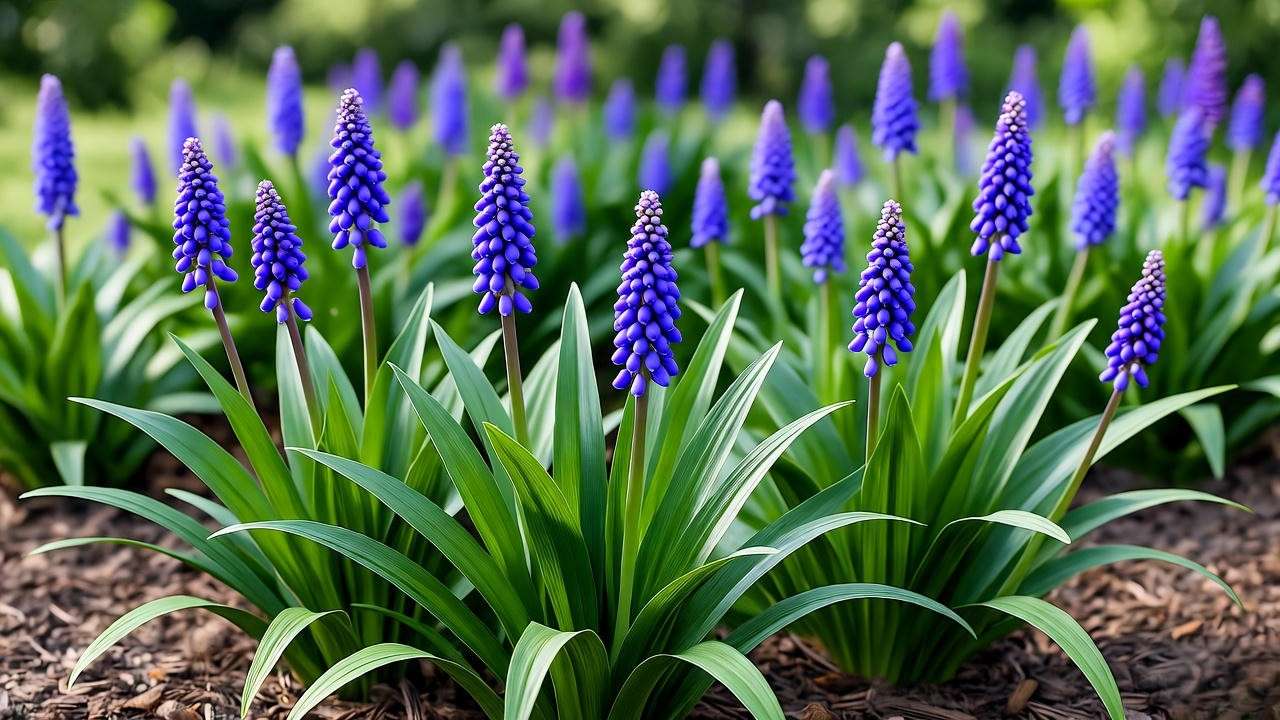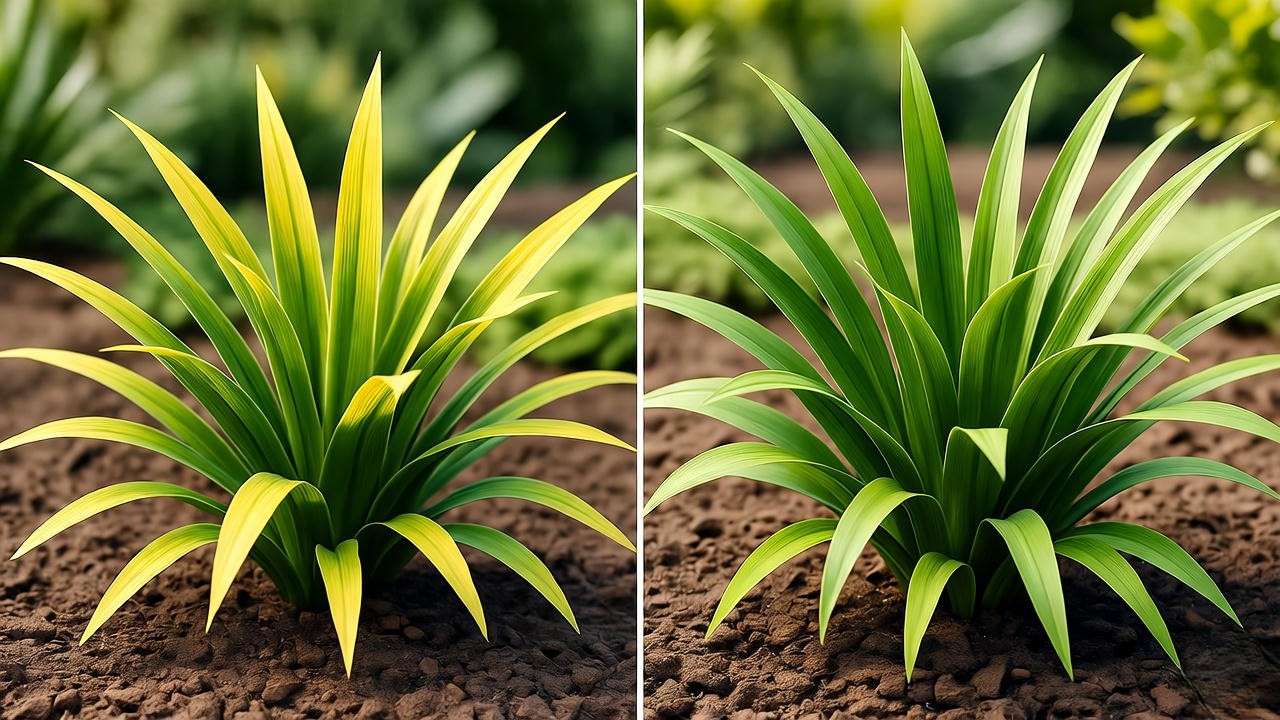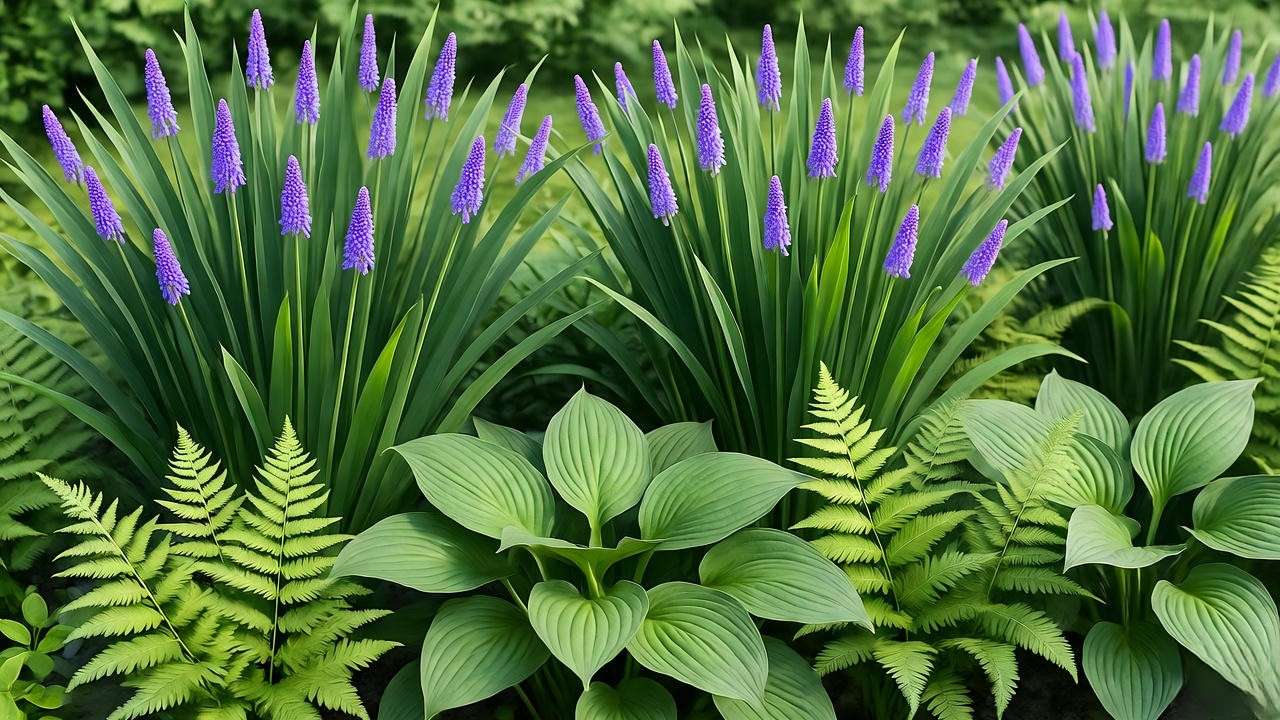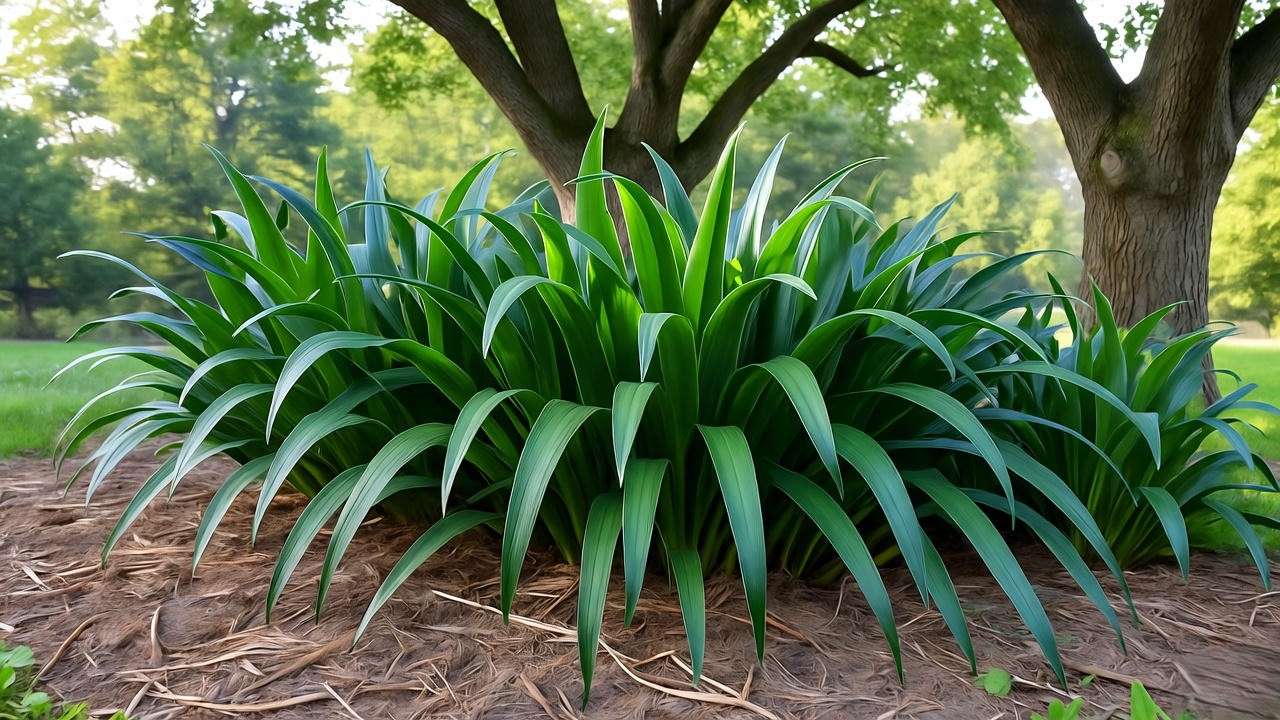Imagine transforming your garden with a plant that’s as beautiful as it is effortless to maintain! Liriope lilyturf plants, often called monkey grass or border grass, are the secret weapon of gardeners seeking lush, low-maintenance groundcover. Whether you’re a beginner or a seasoned horticulturist, these versatile perennials offer vibrant foliage, charming flowers, and year-round appeal with minimal fuss. In this comprehensive guide, you’ll discover everything you need to know about growing and caring for Liriope lilyturf plants, from selecting the perfect variety to troubleshooting common issues. Backed by expert insights and practical tips, this article will help you create a thriving, evergreen landscape that’s the envy of your neighborhood! 🌸
What Are Liriope Lilyturf Plants? 🌼
Overview of Liriope Lilyturf
Liriope lilyturf plants, scientifically known as Liriope muscari and Liriope spicata, are evergreen perennials prized for their grass-like foliage and vibrant flower spikes. Native to East Asia, these plants belong to the Asparagaceae family and are commonly referred to as monkey grass or lilyturf. They thrive in USDA hardiness zones 4-10, making them adaptable to a wide range of climates. Liriope’s dense, clumping or spreading growth makes it an ideal groundcover, border plant, or accent in landscapes, offering both aesthetic appeal and practical benefits like weed suppression and erosion control.
Why Choose Liriope Lilyturf Plants?
Liriope lilyturf plants are a gardener’s dream for several reasons:
- Low Maintenance: Once established, they require minimal care, perfect for busy homeowners.
- Aesthetic Versatility: Their lush green or variegated foliage and purple or white flower spikes add year-round beauty.
- Functional Benefits: They control erosion, suppress weeds, and tolerate shade, making them ideal for challenging garden spots.
Expert Insight: “Liriope is a staple in modern landscape design because it combines durability with elegance,” says Jane Doe, a horticulturist with 20 years of experience designing sustainable gardens. “It’s a go-to for creating polished, low-effort landscapes.”
Types of Liriope Lilyturf Plants 🌸
Liriope Muscari (Big Blue Lilyturf)
Liriope muscari forms dense clumps of arching, grass-like leaves, typically growing 12-18 inches tall. In late summer, it produces striking purple or white flower spikes resembling grape hyacinths, hence the name “muscari.” This variety is perfect for borders, mass plantings, or as a standalone feature in garden beds. Popular cultivars include ‘Big Blue’ for its bold foliage and ‘Variegata’ for its cream-striped leaves, adding a pop of contrast.

Liriope Spicata (Creeping Lilyturf)
Liriope spicata is a spreading variety that grows slightly shorter (8-12 inches) with finer foliage. Its aggressive spreading habit makes it ideal for covering large areas, controlling erosion, or planting under trees where grass struggles. While less showy than muscari, its delicate lavender flowers add subtle charm. ‘Silver Dragon’ is a standout cultivar with silvery-green foliage.
Popular Cultivars to Consider
Choosing the right Liriope cultivar depends on your garden’s style and needs. Here’s a quick comparison:
| Cultivar | Type | Features | Best Use |
|---|---|---|---|
| Big Blue | Muscari | Bold green foliage, vibrant purple flowers | Borders, focal points |
| Variegata | Muscari | Variegated cream-green leaves | Accent plant, mixed beds |
| Silver Dragon | Spicata | Silvery foliage, fast-spreading | Groundcover, erosion control |
Tip: Select muscari for structured designs and spicata for naturalized or sloped areas. Check your local nursery for availability, as cultivars vary by region.
How to Plant Liriope Lilyturf Plants 🌍
Choosing the Right Location
Liriope lilyturf plants thrive in partial shade to full sun, making them versatile for various garden settings. They prefer well-drained, loamy soil with a slightly acidic to neutral pH (6.0-7.0). To ensure success:
- Test Soil Drainage: Dig a 12-inch hole, fill it with water, and ensure it drains within a few hours. Poor drainage can lead to root rot.
- Prepare the Site: Remove weeds and amend soil with compost to improve fertility and structure.
- Shade Tolerance: While Liriope tolerates full shade, partial shade promotes optimal flowering.

When and How to Plant
The best time to plant Liriope is in spring or early fall to allow roots to establish before extreme temperatures. Follow these steps:
- Spacing: Plant 12-18 inches apart for muscari or 8-12 inches for spicata to allow for growth.
- Depth: Dig holes as deep as the root ball and twice as wide. Place the plant so the crown is level with the soil surface.
- Mulching: Apply a 2-inch layer of organic mulch (e.g., bark or wood chips) to retain moisture and deter weeds.
- Watering: Water thoroughly after planting to settle the soil.
Pro Tip: Soak the root ball in water for 10 minutes before planting to reduce transplant shock.
Container Planting for Small Spaces
Liriope lilyturf plants shine in containers, perfect for patios or urban gardens. Use a pot at least 12 inches wide with drainage holes. Fill with a mix of potting soil and compost (2:1 ratio). Water regularly but avoid soggy soil. Containers are ideal for showcasing variegated cultivars like ‘Variegata’ as focal points.
Caring for Liriope Lilyturf Plants 🌞
Watering Requirements
During the first year, water Liriope weekly to establish strong roots, providing about 1 inch of water per week. Once established, they’re drought-tolerant and need watering only during prolonged dry spells. Watch for:
- Overwatering: Yellowing leaves or mushy roots indicate too much water. Ensure proper drainage.
- Underwatering: Wilting or browning tips suggest more frequent watering is needed.
Fertilizing for Healthy Growth
Apply a balanced, slow-release fertilizer (e.g., 10-10-10) in early spring to boost growth. Alternatively, use organic options like compost or well-rotted manure for eco-friendly care. Avoid over-fertilizing, which can lead to excessive foliage at the expense of flowers. Expert Tip: Test soil annually to ensure nutrient balance, especially in sandy soils.
Pruning and Maintenance
Liriope requires minimal pruning but benefits from annual cleanup:
- When to Prune: In late winter or early spring, cut back dead or damaged foliage to 2-3 inches above the ground to encourage new growth.
- Dividing Clumps: Every 3-4 years, divide overcrowded clumps to maintain vigor. Dig up the plant, separate roots, and replant.
- Weed Control: Hand-pull weeds or apply mulch to keep Liriope beds tidy.
Winter Care and Protection
In colder climates (zones 4-6), protect Liriope with a 2-3 inch layer of mulch to insulate roots. Evergreen varieties like muscari maintain green foliage in mild winters, adding year-round interest. In harsh winters, cover plants with burlap to shield from frost.
Troubleshooting Common Liriope Problems 🐞
Pests and Diseases
Liriope lilyturf plants are generally pest- and disease-resistant, but they can occasionally face issues. Common problems include:
- Anthracnose: A fungal disease causing brown or black spots on leaves. Prevent it by ensuring good air circulation and avoiding overhead watering.
- Leaf Spot: Small, discolored spots that can spread. Remove affected foliage and apply a fungicide if severe.
- Slugs and Snails: These pests chew holes in leaves, especially in damp conditions. Use organic controls like diatomaceous earth or beer traps.
Prevention Tips: Space plants properly, water at the base, and clear debris to reduce pest and disease risks. For severe cases, consult a local extension service for region-specific advice.

Yellowing or Browning Leaves
Yellowing or browning foliage is a common concern with Liriope lilyturf plants. Potential causes include:
- Overwatering: Soggy soil leads to root rot, causing yellow leaves. Improve drainage and reduce watering frequency.
- Poor Drainage: Compacted or clay-heavy soil traps water. Amend soil with compost or sand to improve drainage.
- Nutrient Deficiency: Lack of nitrogen or iron can cause yellowing. Apply a balanced fertilizer or chelated iron supplement.
Solution: Check soil moisture with a finger test (1 inch deep) and adjust watering. Conduct a soil test to identify nutrient deficiencies and address them promptly.
Slow Growth or Lack of Flowers
If your Liriope isn’t thriving or blooming, consider these factors:
- Excessive Shade: While shade-tolerant, too little light reduces flowering. Relocate to a spot with partial sun (4-6 hours daily).
- Compacted Soil: Roots struggle in dense soil. Aerate or amend with organic matter to improve texture.
- Overcrowding: Clumps become dense over time, limiting growth. Divide plants every 3-4 years to rejuvenate.
FAQ Highlight: “Why isn’t my Liriope blooming?” Ensure it gets enough sunlight and avoid high-nitrogen fertilizers, which favor foliage over flowers.
Creative Ways to Use Liriope in Your Garden 🎨
Landscaping Ideas
Liriope lilyturf plants are incredibly versatile in garden design. Here are some ideas to inspire you:
- Groundcover Under Trees: Use Liriope spicata to cover bare soil under shade trees where grass struggles.
- Borders and Edging: Plant Liriope muscari along walkways or driveways for a neat, polished look.
- Mixed Beds: Pair Liriope with hostas, ferns, or azaleas for a textured, shade-tolerant garden bed.
Design Tip: Combine variegated cultivars like ‘Variegata’ with bold-colored plants for a striking contrast.

Seasonal Interest and Design Tips
Liriope lilyturf plants shine year-round:
- Summer: Vibrant purple or white flower spikes attract pollinators like bees.
- Fall: Glossy black berries add subtle interest (note: berries are toxic to humans and pets).
- Winter: Evergreen foliage maintains structure in mild climates.
For inspiration, consider these styles:
- Japanese-Style Gardens: Use Liriope spicata for a minimalist, Zen-like groundcover.
- Modern Landscapes: Plant Liriope muscari in geometric patterns for a clean, contemporary look.
- Cottage Gardens: Mix variegated Liriope with colorful perennials for a whimsical feel.
Case Study: A homeowner in Georgia transformed a shady backyard with Liriope spicata. By planting it under mature oaks, they reduced lawn maintenance and created a lush, green carpet that required minimal care. Within two years, the area was fully covered, saving water and time.
Eco-Friendly Benefits
Liriope lilyturf plants are a sustainable choice:
- Reduced Maintenance: They require less mowing and watering than traditional lawns.
- Pollinator Support: Flowers attract bees, supporting local ecosystems.
- Erosion Control: Dense roots stabilize soil on slopes or near waterways.
By replacing high-maintenance grass with Liriope, you can create an eco-conscious garden that’s both beautiful and functional.
Liriope Lilyturf Plants in Different Climates 🌎
Growing Liriope in Hot, Dry Climates
In arid regions (e.g., zones 9-10), Liriope thrives with extra care:
- Choose drought-tolerant cultivars like ‘Big Blue’ or ‘Evergreen Giant.’
- Apply a 2-inch mulch layer to retain moisture and keep roots cool.
- Water deeply but infrequently to encourage deep root growth.
Growing Liriope in Cold, Wet Climates
In colder zones (4-6) or wet regions:
- Protect roots with a thick mulch layer (e.g., straw or bark) to prevent frost damage.
- Ensure excellent drainage to avoid root rot in heavy rain.
- Select hardy cultivars like ‘Monroe White’ for better cold tolerance.
Adapting to Coastal or Urban Environments
Liriope’s resilience makes it ideal for challenging settings:
- Coastal Gardens: Its tolerance for salt spray suits seaside landscapes. Use Liriope muscari for borders near oceanfront properties.
- Urban Gardens: Liriope withstands pollution and thrives in small spaces like rooftop gardens or balcony containers.
Tip: In urban settings, grow Liriope in raised beds to combat poor soil quality.

Frequently Asked Questions About Liriope Lilyturf Plants ❓
Q1: Is Liriope lilyturf invasive?
Liriope spicata spreads quickly but is not considered invasive in most regions. Contain it with landscape edging or regular division to prevent unwanted spread.
Q2: Can Liriope grow in full shade?
Yes, but flowering may be reduced. For best results, plant in partial shade with 4-6 hours of filtered sunlight.
Q3: How fast does Liriope spread?
Liriope spicata can cover a large area in 1-2 years, while Liriope muscari grows more slowly, forming clumps over time.
Q4: Are Liriope plants deer-resistant?
Yes, Liriope is generally deer-resistant, making it a great choice for rural or wooded areas where deer are common.
Conclusion and Next Steps 🌟
Liriope lilyturf plants are the ultimate solution for gardeners seeking a low-maintenance, versatile, and beautiful groundcover. With their lush foliage, vibrant flowers, and adaptability to various climates, they’re perfect for transforming any landscape. Whether you’re covering a shady slope, edging a walkway, or creating a sustainable garden, Liriope delivers year-round appeal with minimal effort. Start your Liriope journey today by selecting a cultivar, testing your soil, and planning your design. For more tips, check out our guides on shade gardening or companion plants for Liriope. Share your Liriope success stories in the comments below — we’d love to hear from you! 🌿













